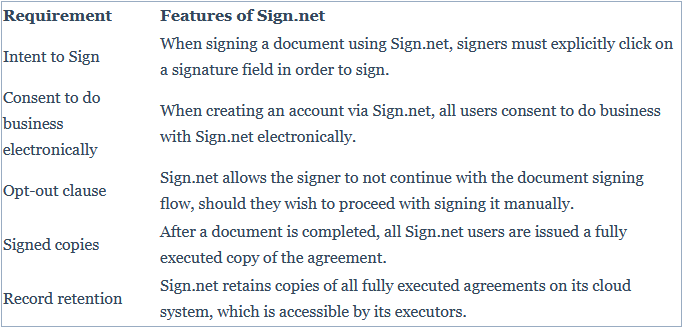How does Sign.net comply with UETA and E-Sign Act?
Legal framework
T H Kwek
Last Update 3 years ago
In the US, the use of e-signatures is governed by the Electronic Signatures in Global and National Commerce (ESIGN) Act and the Uniform Electronic Transactions Act (UETA). This article aims to highlight the key provisions of both Acts, and the differences between them.
What is the Electronic Signature in Global and National Commerce?
ESIGN Act
The Electronic Signatures in Global and National Commerce (ESIGN) Act is the US Federal law governing the use of electronic records and electronic signatures in the US. Under the ESIGN Act, electronic records and signatures are legally valid. In other words, in every US State and US territory where federal law applies, electronic records and signatures have the same legal effect as traditional contracts and signatures.
Key points of the ESIGN Act:
- Provides that electronic signatures have the same legal effect as pen-and-ink signatures;
- Provides that any law with a requirement for a signature may be satisfied by an electronic signature;
- Prevents denial of legal effect, validity or enforceability of an electronic signature document solely because it is in an electronic form; and
- Provides that electronic contracts and agreements can be used as evidence in court.
Exceptions where electronic signatures are not applicable
The following is a list of documents where the use of electronic signatures is not appropriate.
- Wills and related amendments;
- Adoption, divorce, and other matters of family law;
- Court orders or notices, or official court documents;
- Contracts or documents governed by the Uniform Commercial Code (UCC);
- Notices of cancellation or termination of utility services;
- Notices of default, acceleration, repossession, foreclosure or eviction;
- Cancellation or termination of health or life insurance benefits;
- Health or safely recall or material failure notices of a product;
- Documentation for transportation or handling of hazardous or toxic material.
What is the Uniform Electronic Transactions Act (UETA)?
The UETA is a model Electronic Transactions Act drafted by the Uniform Law Commission of US. This Act, where adopted, constitutes State laws. It should be noted that the provisions in the ESIGN Act take precedence over the UETA, because the ESIGN Act constitutes Federal law.
UETA has since been adopted by 48 states, the Disrupt of Columbia, Puerto Rico and the US Virgin Islands. However, two states, Illinois and New York, have not adopted the UETA . Instead, Illinois and New York have implemented their own state laws governing esignatures.
Key provision of UETA:
- If a law requires a signature, an electronic signature satisfies that law;
- If a law requires a record to be in writing, an electronic record satisfies the law.
Exceptions where electronic signatures are not applicable:
See above.
Difference between ESIGN and UETA?
In the US, the ESIGN Act and UETA were put in place to govern the application of esignatures. Both share the common purpose of making transactions simpler and quicker.

Elements of legally binding electronic signatures under ESIGN
1. Intent to Sign. Similar to pen signatures, a signer must show clear intent to sign the electronic agreement. These are a list of examples of when clear intention may be found.(this link is to be remove, 10 May 2022)
2. Consent to do business electronically. There needs to be “terms” to which the signer is agreeing to. This may come in the form of a standard consent clause, or an option to customize the consent clause. Ex. “I agree to allow XYZ Company to retain my personal data for as long as it is necessary to fulfill the purposes for which they were collected, or as required or permitted by applicable laws.”
3. Opt-out clause. Where a signer does not want to sign an agreement electronically, clear instruction on how to sign an agreement manually should be made easily accessible to the signer.
4. Signed copies. All signers should be able to access, or receive a fully executed copy of the agreement.
5. Record retention. To legitimize the validity of electronic records, they need to accurately reflect the agreement and must be able to be reproduced where required.
Sign.net ensures legal significance of documents


